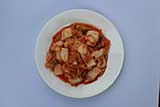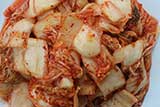Meats and Sausages
Kimchi
Kimchi is a traditional fermented Korean dish made of cabbage with varied vegetables and seasonings.
Kimchi main ingredients are:
- Chinese cabbage
- White radish
- Green onions
- Ginger
- Garlic
- Hot peppers
These nutritious vegetables are mixed and allowed to ferment in order to create what we call kimchi. Kimchi is also an ingredient for many other dishes where pickled baby shrimp, oysters or salted fish sauce may be added. Several types of kimchi exists, including regional and seasonal variations. It is believed that the name kimchi originated from shimchae (salting of vegetable). The Korean people absolutely love this side dish with rice, which is well known for its spicy flavor. Some of the foods made with kimchi include: kimchi-jjigae (stew), kimchi-guk (soup), kimchi-jeon (a Korean-style pancake), and kimchi fried rice. These days kimchi has been incorporated into Western style foods such as hamburgers and pizza, which are loved by many.
As cabbage is basically a winter vegetable, the greatest varieties of kimchi were prepared during the early winter. November and December are traditionally when people begin to make kimchi; women often gather together in each others homes to help with winter kimchi preparations. Korean immigrants to China, Russia, Hawaii and Japan first introduced kimchi abroad, and have continued to eat kimchi as a side dish. It gradually gained popularity even among foreigners. Accordingly, kimchi may be found wherever Koreans live. In America packaged kimchi is easily available in major supermarkets. In the past, the production and consumption of kimchi was confined to Korean societies, however, in recent years it has become a globally recognized food.
Kimchi and Hot Red Pepper
As a kind of pickled vegetable, kimchi was born in Korea around the 7th century. Many years ago, kimchi was simply regarded as a salted vegetable. Early kimchi was made of cabbage and beef stock only. Red chili, a New World vegetable not found in Korea before European contact with the Americas, was introduced to Korea from Japan after the Hideyoshi Invasions (1592-1598) and became a staple ingredient in kimchi. Red chili pepper flakes are now used as a main ingredient for spice and a source of heat for many varieties of kimchi. This also accounts for the reddish color of kimchi. Kimchi as we know it today has retained the same qualities and cooking preparations that prevailed ever since it was first introduced centuries ago. Kimchi is a much more elaborate dish than European sauerkraut, which even today is basically fermented shredded cabbage with added salt. Most Europeans do not fancy adding red hot peppers into sauerkraut. At the beginning of the winter season a traditional Korean farm family would process one or two hundred cabbage heads for making kimchi. Kimchi was stored in the ground in large jars which were covered with a straw cushion and kept in a designated storage area. Nowadays, vegetables can be grown throughout the year in green houses so there is less need to process huge quantities of kimchi at one time. The storage is often accomplished in modern kimchi refrigerators that offer precise temperature controls. Such an appliance is designed specifically to meet storage requirements of various kimchi types, including temperature control and different fermentation processes. In consumer surveys aimed at Korean housewives, the kimchi refrigerator ranks first always on top of the list as the most wanted household appliance. They are also great for storing wine, vegetables, fruits, meat, fish and other foods because these refrigerators are designed to offer a constant-temperature environment so that you can store foods fresh much longer than ordinary refrigerators. They can also be used as freezers.
Kimchi Benefits
Kimchi like its Western counterpart sauerkraut are probiotics. This is due to the presence of lactic acid bacteria that produce lactic acid. Resulting lactic acid in kimchi restrains the growth of harmful bacteria in the intestines and helps relieve intestinal disorders. Kimchi is also credited for preventing adult diseases such as obesity, diabetes, and even gastrointestinal cancers. Juices from the vegetables and salt in kimchi help the intestines remain clean as well. Korea has been officially credited with preventing SARS disease. Recently, SARS influence has struck many places throughout Asia. Severe acute respiratory syndrome (SARS) is a serious form of pneumonia. It is caused by a virus that was first identified in 2003. Infection with the SARS virus causes acute respiratory distress (severe breathing difficulty) and sometimes death. Korea has managed to stay SARS-free and some are saying that the reason for this can be found in kimchi.















